A modernist in Geneva - Le Corbusier and the competition for the Palais des Nations
Marco Ninno (MA Student - Aarhus University)
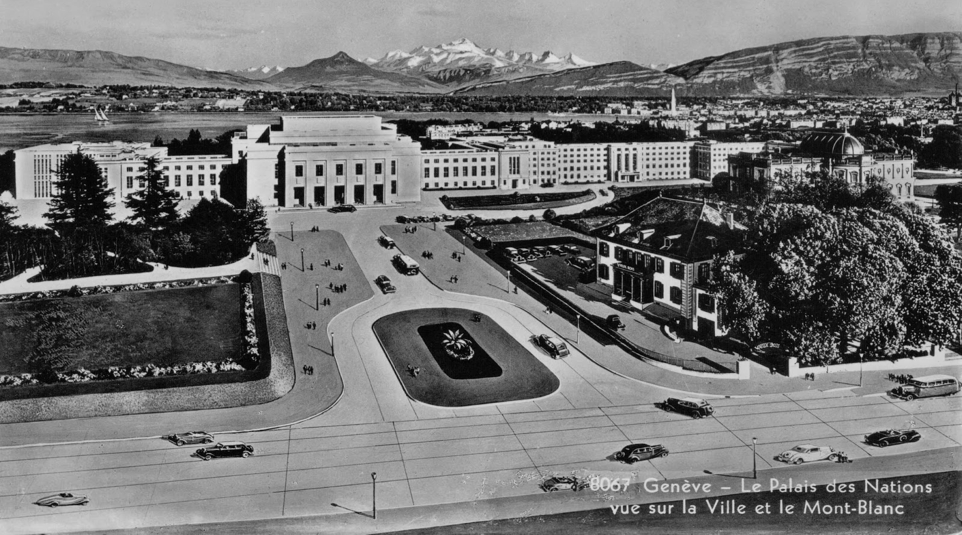
Post Card, Les Palais des Nations
Researching for a paper about the construction of the headquarters of the League of Nations – the Palais des Nations in Geneva – I stumbled upon the history of architect Le Corbusier’s involvement in the conception of the Palais. Le Corbusier, as we will see, was the victim of a double snub: first the hard-core modernist was weeded out in the prestigious architect competition the League arranged, as the competition Jury came to emphasize the traditional traits of a palace structure.
After a new round of competitions, following a major debacle about the building site, Le Corbusier was cheated again: The Jury’s preferred architect had been inspired by Le Corbusier’s drawings to a suspicious degree. As with so many other aspects of the League, however, the story continued into the postwar years, as Le Corbusier retrieved his honour by becoming one of the key architects behind the new United Nations building in New York.
The importance of semantics
Since the time of the roman emperors, the term “palace” has been used to indicate the physical seat of power. As is often the case in Western history, the glory of the Roman Empire inspired following civilizations, and the term palatium, or palace, never lost its ideological charge. Instead, it became part of the vocabulary of every modern language, employed to indicate the physical location of power. A simple search on Google images for “palace”, displays how this term is linked with images of Greco-Roman architecture and monuments of power and prestige. It was the meaning and etymology of the word ‘palace’ that would cause so much trouble for the modernist architect Le Corbusier.
In its early days in Geneva, the League of Nations Secretariat were quartered at the Hôtel National. It was clear from the beginning that the hotel was ill-suited as an administrative building. When the Swiss authorities offered a site for a new conference hall, therefore, the League seized the opportunity: in 1924, the Assembly asked for a building which was to “perform fully and adequately the essential function and purposes of an Assembly Hall of the League of Nations”. [1] The League opted for an international competition, whose guidelines were written down by an international Jury, in order to clarify and emphasise the great ideological and symbolic importance of the construction of the first world parliament.
The Jury believed that “it was the idea of the League of Nations which had to inspire the construction of the building, and that it was from an understanding of the world based on brotherhood that the architectural realization had to be emanated”. [2] This idea seemed to crave modernity. A modernity expressed through a new architectural concept for the physical seat of power - which is why so many modernist architects took part in the competition with great enthusiasm.
Despite the fact that this was to be the headquarters of an organisation that sought to break with the past of secret diplomacy and fleeting alliances, the Jury, after having referred to the building as a Conference or Assembly Hall, decided, in the official guidance for the competition, to opt for the history-laden term “the Palace”. [3]
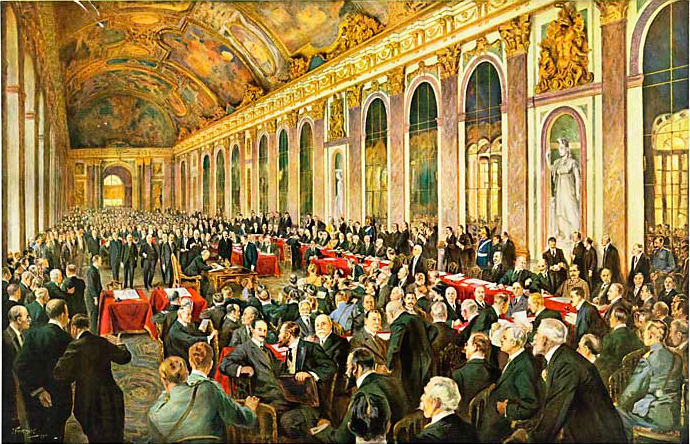
The Signing of the Treaty of Peace at Versailles - June 28th 1919
Through this semantic alteration, the Jury implicitly foresaw the League headquarters as a site of traditional power and diplomacy, akin to the Palace of Versailles – where the League was born. The troubled case of the exclusion of the modernist architect Le Corbusier would lay the traditionalist inclination of the Jury bare.
Le Corbusier case
By the deadline of the competition, January 1926, 377 different projects had reached Geneva. Due to the big response, and differing views within the Jury, the verdict was not an easy one. To this came the fact that an overwhelming majority of the projects chose to ignore the rules set up by the Jury. Most projects, for instance, exceeded the budget limit of 13 million francs stipulated by the Jury; some of them reaching estimates of 50 million francs.
Ultimately, therefore, the final decision was to recommend, not a single winner, but 27 different ones – a decision that was heavily criticised. The Jury was accused of having neglected their own budget limits, nominating projects estimated to cost more than 13.000.000 francs, and also to have ignored the fundamental premise of the competition by nominating 27 different ‘winners’. Thus, a Committee of Five, consisting of seasoned diplomats, was nominated to resolve the impasse. Unsurprisingly, they came out in favour of the Jury, considering that the path chosen had been inevitable, since none of the projects respected the conditions of the competition.
This position was, however, soon questioned by part of the specialized public opinion, which started gathering around one project that scrupulously respected the regulation. The architects Le Corbusier and Pierre Jeanneret – one of the 27 winners – had, as it turned out, presented a project which fulfilled all the criteria of the competition, with an estimated expenditure of 12.500.000 million francs.
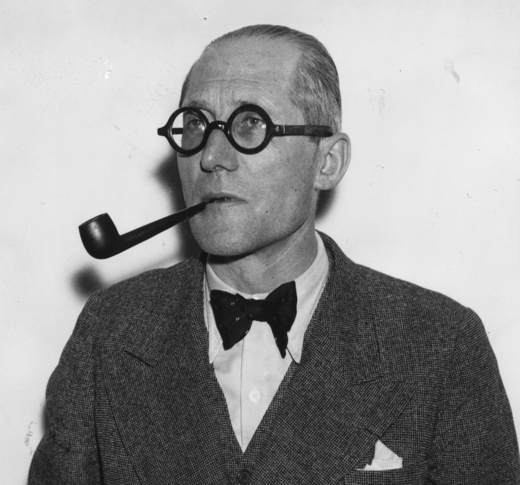
Le Corbusier
The Jury, on the other hand, intent as it was to avoid a modernist winner, clung to a minor deviation in the Le Corbusier-project: its prospects were machine printed, and not hand-drawn like the regulations required. Critics argued, however, that the real problem was that Le Corbusier’s proposed building broke with the traditional notions of a ‘Palace’.
This was certainly true: The two architects presented a path-breaking building which had nothing in common with the palaces of the past. On the contrary, it resembled more a modern office where actual work could be carried out in a convenient way. Neither did the architects hide the ideological charge of their project. In the competition record annexed to the project, in fact, they addressed the Jury stating that:
if the intentions of the League of Nations [to represent the pacific glory of the XX century] are sincere, then it is not possible to constrain such an innovative social organization to the straitjacket of traditional architecture. No colonnaded hall for bored sovereigns, but salubrious working rooms for the busy representatives of the various peoples. No dark corridors for the intrigues of diplomacy, but open, glazed spaces for public negotiations carried by honest men. [4]
In the midst of this controversy, many proposed an entirely new competition. The proposal was well timed, as John D. Rockefeller Jr recently had offered the League to pay for the construction of a library worthy of the institution. Such an important addition to the Palace would substantially change the parameters of the building. Despite these considerations, the Committee of Five – determined to avoid a second round – declared themselves bound, by mandate, to choose between one of the nominated projects.
Determined not to fall victim to diplomatic trickery, Le Corbusier decided to address an extensive plea to the president and the members of the Council of the League, in which he urged them to reject the decision of the Committee of Five and to “adopt a solution […] respectful of the principles which are at the basis of the organization of the competition and which inspired the mandate entrusted to the Committee of Five”. [5]
Despite the unassailable evidence presented in Le Corbusier’s plea – impeccably drafted by André Prudhomme, at the time one of Paris’ top lawyers – the Council did not include it in its order of the day. As a result, the resolution of the Committee of Five was passed by the Council on 6 March 1928, officially endorsing the controversial results of the competition. [6]
Months later, the Secretariat of the League explained that the reason why the petition was not presented to the Council was that no private citizen could directly appeal to the organs of the League. [7] It is worth noticing though, that on 6 March 1928, the president of the Council, to whom the plea was addressed, was none other than Dr. Francisco J. Urruita, the Colombian member of the Committee of Five. Moreover, Japan was represented at that meeting of the Council by M. Mineitcirô Adatci, president of the Committee of Five. [8]
The Ariana Park and the plagiarism
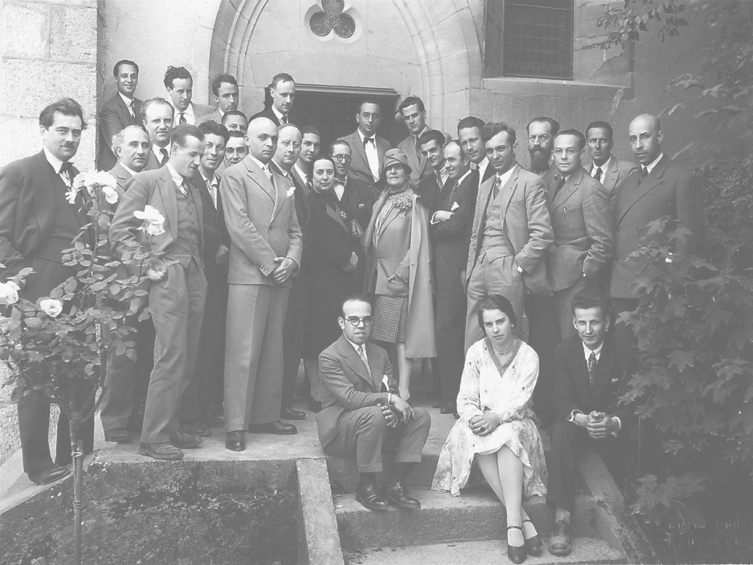
International Congress of Modern Architecture 1928-29 (in the center: M.me de Mandrot and Le Corbusier)
Diplomacy, however, could not change the fact that if the library sponsored by Rockefeller was to be built, a bigger site for the Palace was needed. With help from the Swiss authorities, the League could appropriate a new site – known as the Ariana Park – where the Palace would eventually find its final seat. The park, though, had been donated to the city of Geneva by the late Gustave Revilliod, and his heir, Hélène de Mandrot Revilliod, had the final say on the use of the site. Unfortunately for the Jury, the Committee of Five and the League, M.me de Mandrot had followed the case of Le Corbusier and favoured his project. In exchange for her consent, she therefore asked that all the architects awarded with a first prize in the competition would be allowed to present a new project for the Ariana site. Being short on time, the League accepted the conditions and could present the new solution to the Assembly reunited in September 1928. Therefore, on 25 September, the Assembly approved the choice of the Ariana Park as the new site of the Palace and conferred to the Committee of Five all the necessary powers to head a quick and successful process. [9]
With Mme de Mandrot’s conditions, Le Corbusier’s project was back in the game. The League and the Committee of Five, however, had no difficulties in untying the strings attached to the Ariana Park site. Even if Le Corbusier was invited to present a new project – which he did in April 1929 – the League had already signed the contract with the architects backed by the Committee of Five one month before.
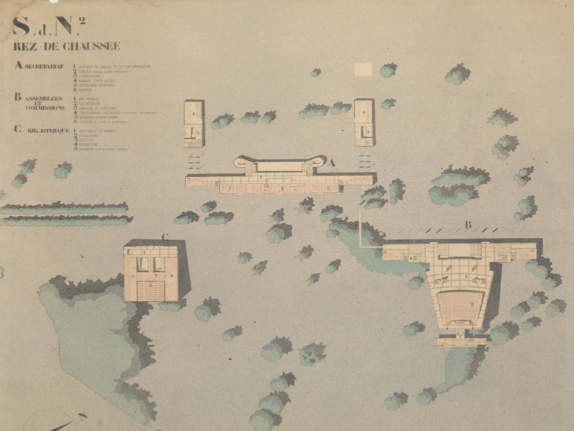
Le Corbusier - Project for the Ariana Park
Thus, the Committee of Five recommended project won through – but that was not the end of the controversy. In 1931, Le Corbusier filed a plagiarism complaint against Nénot and the other architects of the project under way. Once confronted with the definitive project, Le Corbusier noticed that the general concept – the planimetrics, the distribution, and many other aspects which characterize an architectural project – were inspired by the original conceptions present in his project. Furthermore, he argued that the final project presented for the Palace had only few similarities with the first projects presented by the architects entrusted with the construction of the building. Nénot had, as the drawing below indicate, stolen several of the general concepts from Le Corbusier, while retaining a classical 'palace' appearance. This was a kind of reluctant admission of the need for something new: Like the League itself, the building thus became both novel and built on tradition.
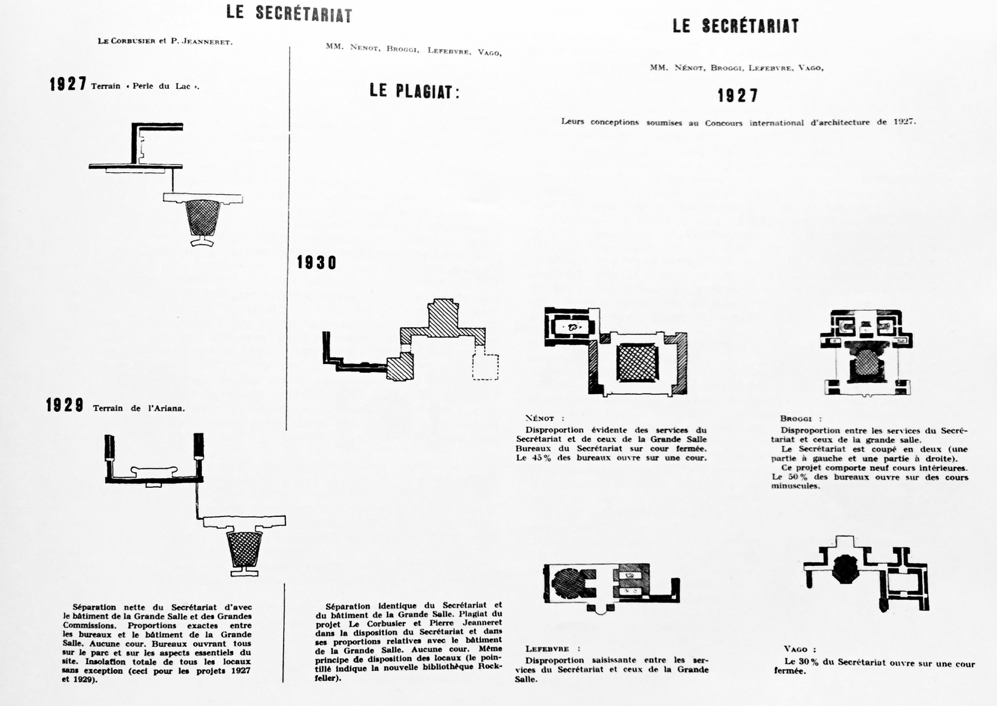
Table attached to Le Corbusier's plea to prove the plagiarism: According to Le Corbusier it was primarily the distribution of the volumes, the actual shape of the palace, that was plagiarised. In particular, Le Corbusier was the only one who proposed an open courtyard, whereas the others opted for a courtyard surrounded by walls (the symbolic "openness" of his project - as opposed to the more traditional enclosed courtyard - was consequently 'borrowed')
Despite strong evidence of plagiarism, the League rejected the second plea on the same grounds as it did the first one. Thus, the works for the Palace were set to start on 1 March 1931 – the start of a long and troubled construction process.
As regards Le Corbusier, we can reassure the reader that he had his own personal compensation. With the extinction of the League of Nations in 1946, its successor, the United Nations, needed a new home far from Geneva and the allure of failure surrounding the Palais. A new modern building, a glazed skyscraper in the middle of New York City, would serve the cause and its realization was entrusted to a team of architects, among whose names stands out a familiar one: the one of Le Corbusier.
References:
[1] League of Nations Official Journal - Special Supplement, 23/156 (1924).
[2] Minutes of the second session of the works of the Jury (January 1926), pp. 31-33, League of Nations’ Archives 32/49424/28594 in Ilda Delizia, Fabio Mangone, Architettura e Politica. Ginevra e la Società delle Nazioni, 1925-1929 (Roma: Officina Edizioni, 1992), 26.
[3] Programme et Règlement du Concours d’Architecture pour l’édification d’un Palais de la Société des Nation à Genève, April 17th, 1926.
[4] See competition report in H. J. Wittwer, Hans Wittwer 1894-1953, Zurich: 1985, 28-29.
[5] Requête adressée par Mm. Le Corbusier et P. Jeanneret à M. le President et à Mm. les Membres du Conseil de la Société des Nation, Paris: February 28th 1928 in Anzivino, Il Concorso per il Palazzo della Società delle Nazioni, 96-99.
[6] League of Nations Official Journal, 9/383 (1928).
[7] Le Corbusier, Une Maison-Un Palais (Paris 1928) in Anzivino, Il Concorso per il Palazzo della Società delle Nazioni, 101.
[8] League of Nations Official Journal, 9/367 (1928).
[9] League of Nations Official Journal – Special Supplement, 64/163 (1928).
Sources:
Ciro Luigi Anzivino, Ginevra 1927: il concorso per il Palazzo della Societa delle nazioni e il caso Le Corbusier (Firenze: Modulo Editore, 1979).
Ilia Delizia, Fabio Mangone, Architettura e politica : Ginevra e la Società delle nazioni, 1925-1929 (Roma: Officina edizioni, 1992).
Jean-Claude Pallas, Histoire et architecture du Palais des Nations (1924-2001): l'Art déco au service des relations internationales (New York: United Nations publication, 2001).
Images:
Postcard: http://thejonesgenealogist.blogspot.it/2014/07/
Le Corbusier: http://www.eliconie.info/?tag=Le+Corbusier
Group Picture: https://www.thinglink.com/scene/612974990475657216
Ariana Park Project: https://www.moma.org/collection/works/88320?locale=it
Table: Anzivino, Ginevra 1927, p. 104.
